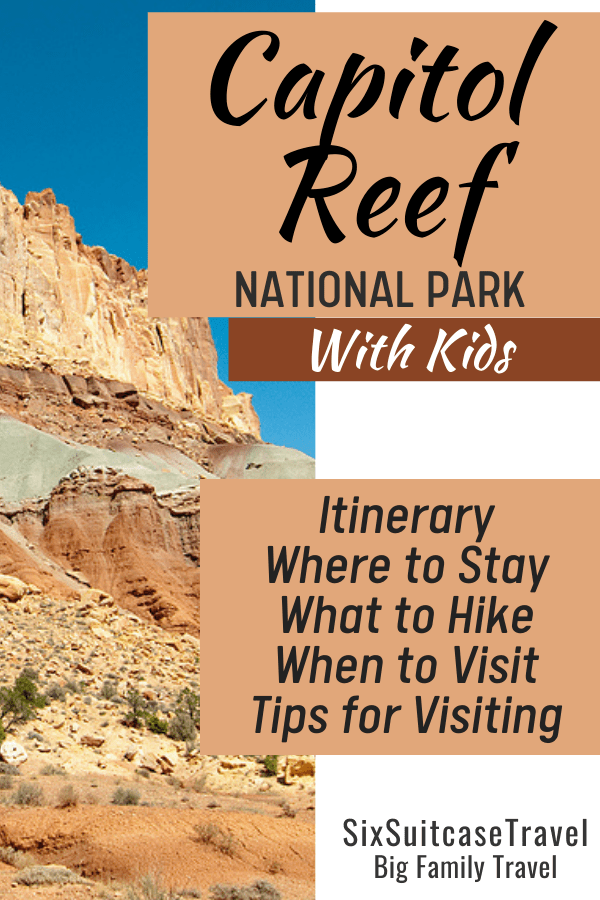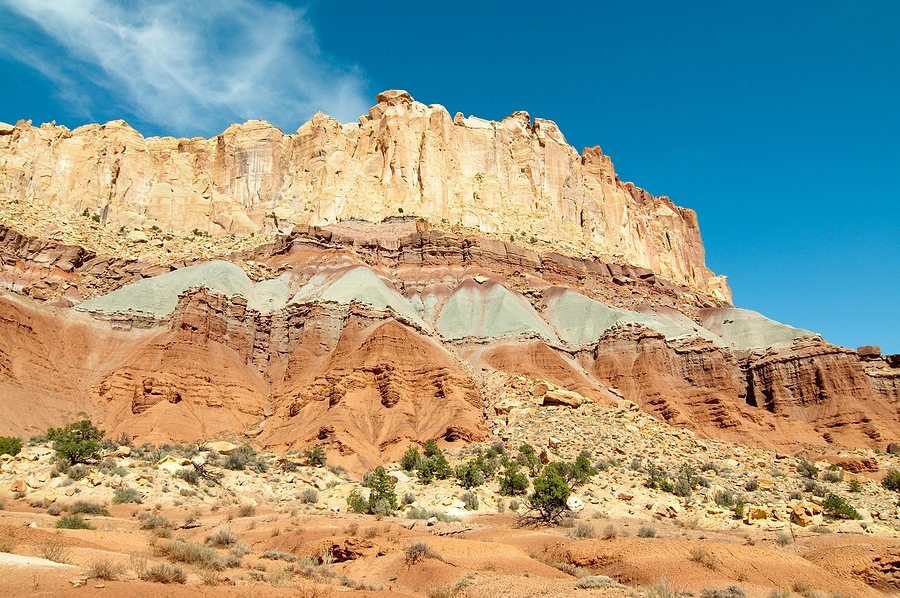
Capitol Reef National Park offers magnificent views of red rock cliffs, canyons, domes, and bridges. The star of the park is the Waterpocket Fold. This 100-mile-long buckle in the earth’s surface reveals multiple rock layers and creates deep narrow canyons and formations.
As the lesser-known of Utah’s 5 National Parks, Capitol Reef only receives 1.2 million visitors a year. The smaller crowds will make your visit to the park more enjoyable. Although many visitors will just complete the Scenic Drive and leave, there is much more to the park. Use our list of activities, hikes, and itineraries to help you plan a visit your family will enjoy.
Having spent time exploring Capitol Reef National Park, we’ve gathered expert tips and insights to help you navigate your own adventure with ease.
- Where is Capitol Reef National Park?
- Getting to Capitol Reef National Park
- 10 Activities with Kids at Capitol Reef
- Best Capitol Reef Hikes with Kids
- How Many Days Do You Need at Capitol Reef National Park?
- Entrance Fees for Capitol Reef National Park
- Can You see Capitol Reef and Bryce Canyon in One Day?
- Best Time to Visit
- 12 Tips for Visiting Capitol Reef with Kids
- Where to Stay
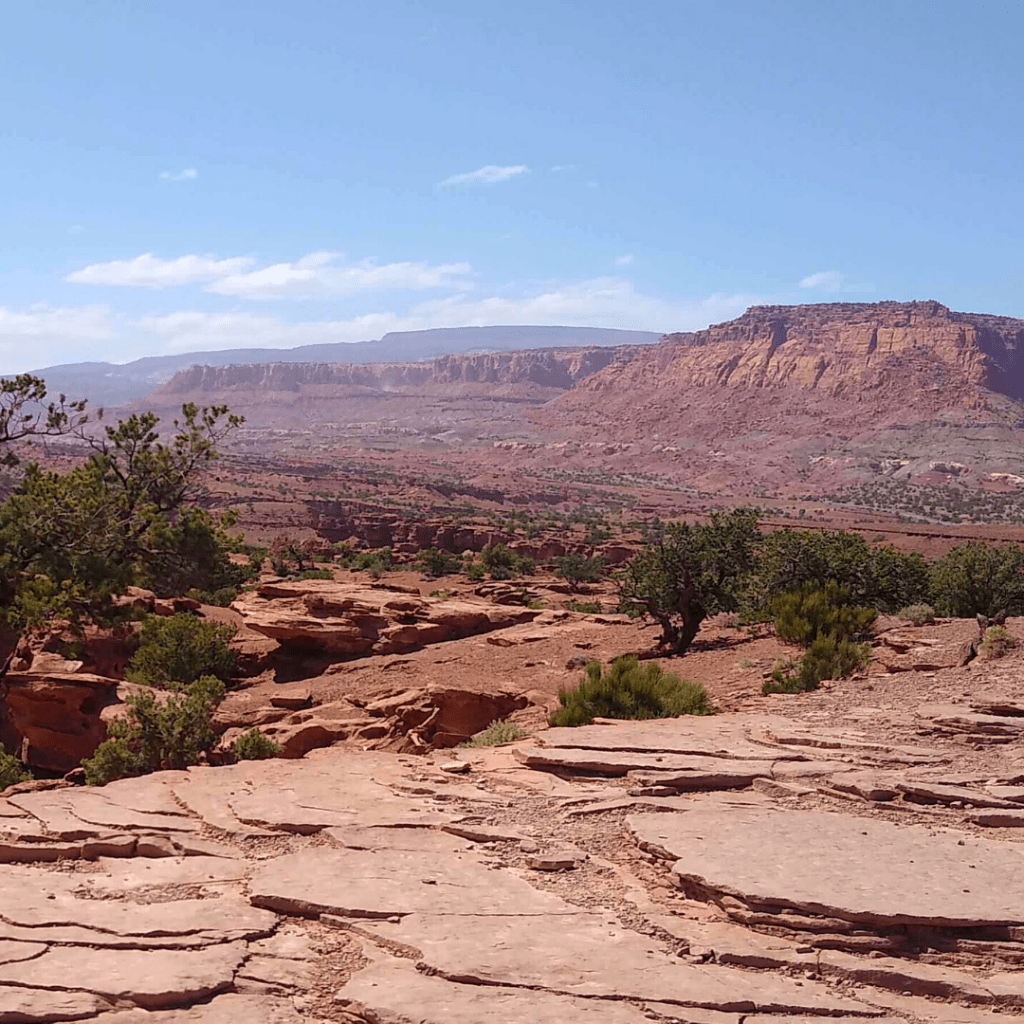
Where is Capitol Reef National Park?
Capitol Reef National Park is located in south-central Utah, nestled in the heart of red rock country. The park covers an area of over 241,000 acres and is part of the scenic and geologically rich Colorado Plateau. It is situated along Utah State Route 24 (UT-24), making it easily accessible by car from many popular Utah destinations.
Capitol Reef is approximately:
- 3.5 hours (218 miles) from Salt Lake City, Utah.
- 2 hours (126 miles) from Moab, Utah (near Arches and Canyonlands National Parks).
- 2 hours (112 miles) from Bryce Canyon National Park, making it an ideal addition to a Mighty 5 road trip through Utah’s incredible national parks.
- 4 hours (231 miles) from Zion National Park.
The park’s closest town is Torrey, Utah, just 10 miles from the entrance. This small but well-equipped town offers restaurants, lodging, gas stations, and other traveler amenities. Torrey serves as a convenient base for exploring the park. Make sure to stock up on supplies before heading to the more remote areas of the park
Getting to Capitol Reef National Park
- From Salt Lake City: Take I-15 south to US-50 east, then connect to UT-24. This route offers a scenic drive through Utah’s rural countryside.
- From Moab: Take UT-191 north, then UT-70 west, and finally UT-24 west to the park. Consider stopping at Goblin Valley State Park along the way, a fun detour for visitors traveling with kids.
- From Bryce Canyon National Park: Drive north on UT-63 to UT-12, one of America’s most scenic highways, and then connect to UT-24 east. Along the way, you’ll pass through Grand Staircase-Escalante National Monument, which features plenty of viewpoints, trails, and photo opportunities.
10 Activities with Kids at Capitol Reef
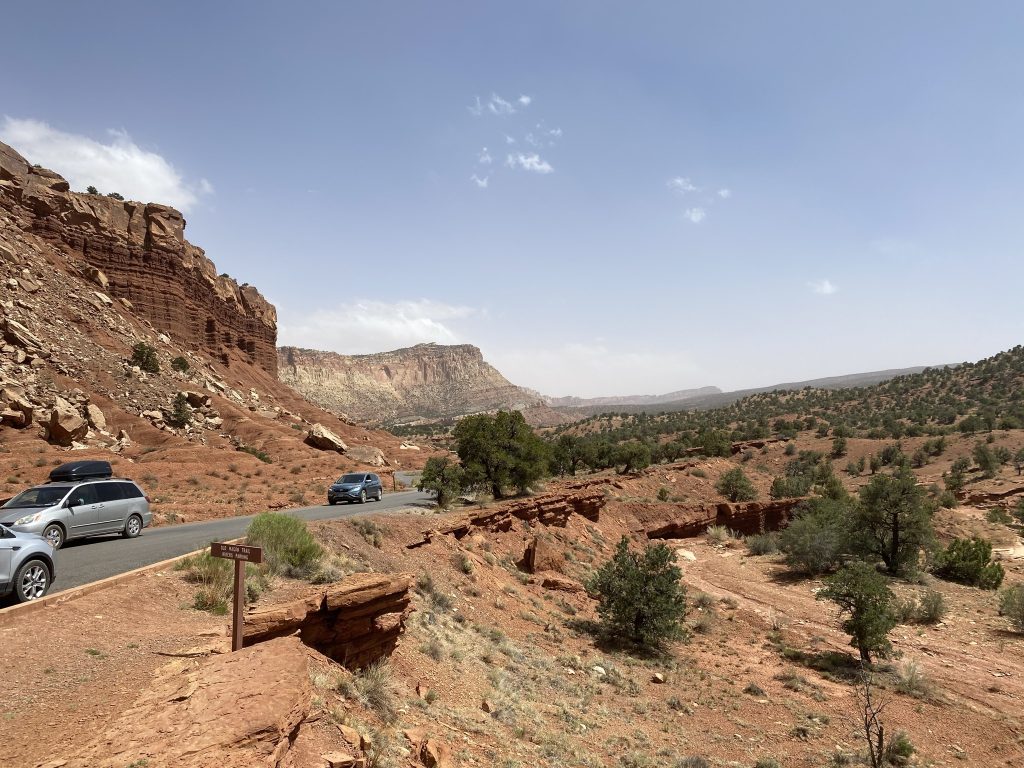
1. Capitol Reef Scenic Drive
The Capitol Reef Scenic Drive is an 8-mile-long paved road that takes you through some of the most stunning landscapes in the park, offering unforgettable views of the unique rock formations and the iconic Waterpocket Fold.
The drive features 11 marked stops at viewpoints and pullouts. Grab a Scenic Drive Guide at the visitor center to learn about each stop. Allow at least 2 hours for the drive, depending on how much exploring you plan to do at the stops.
Don’t stop at just the paved section! The two unpaved spur roads, Grand Wash Road and Capitol Gorge Road, offer additional exploration options.
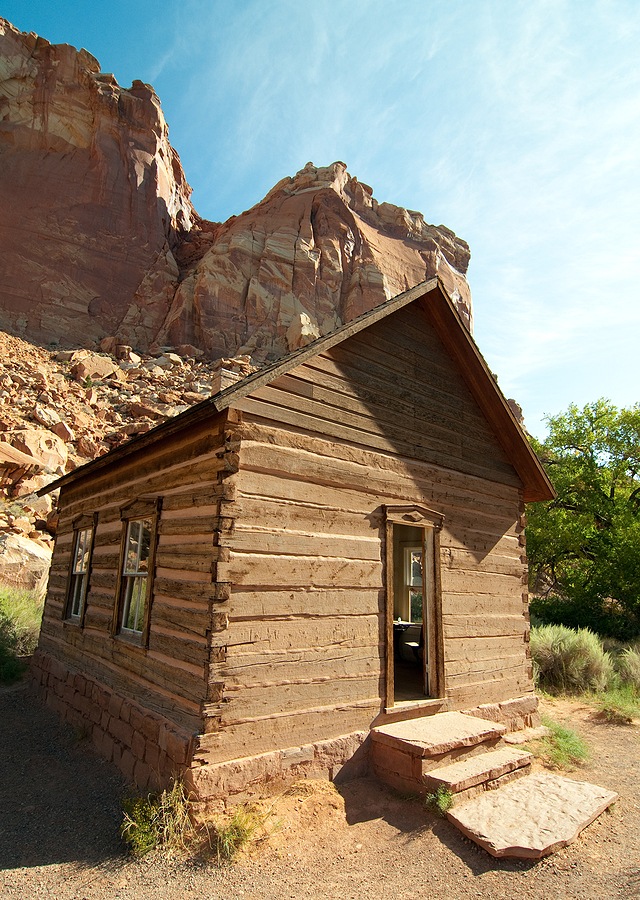
2. Explore the Fruita Historic District
The Fruita Historic District is a fascinating and scenic area where families can step back in time to learn about the lives of Mormon settlers who lived here in the late 19th and early 20th centuries.
Highlights include the Gifford House, the restored Fruita Schoolhouse (built in 1896), and a historic blacksmith shop. Kids will enjoy wandering around these remnants of the past and imagining life in a small frontier community.
3. Eat Pie at the Gifford House
The Gifford House, part of the Fruita Historic District, now operates as a gift shop and bakery, offering travelers a chance to relax with treats like freshly baked pies, cinnamon rolls, and jams. The pies are made from fruits harvested from the surrounding orchards, such as cherries, peaches, and apples. Arrive early in the day, as the pies and baked goods often sell out by mid-afternoon. We suggest buying multiple flavors to let everyone share and taste the different kinds.
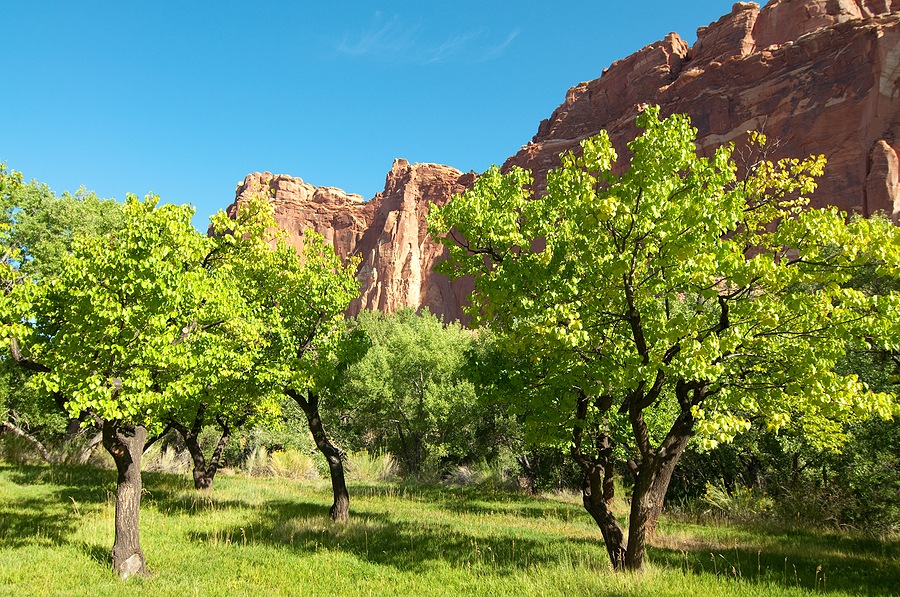
4. Pick and Eat Fruit at the Orchards
Capitol Reef is famous for its historic orchards, which feature more than 3,000 fruit trees, including cherries, apricots, peaches, pears, and apples.
If you visit during the fruit-picking season (June through October, depending on the fruit), kids can pick and eat fruit fresh from the trees. This hands-on activity is both fun and educational, with interpretive signs explaining the history behind the orchards. You can pick fruit for free to eat while exploring, though there is a small fee for taking fruit with you. Check in at the visitor center to find out what fruits are ripe for picking during your visi and remember to bring a bag with you.

5. Read the Petroglyph Panel
The Fremont Culture Petroglyphs are a must-see for families. Kids will be fascinated by the ancient artwork left behind by the Fremont people, who lived in the region over 1,000 years ago. The petroglyphs, which include vivid depictions of warriors, bighorn sheep, and human figures, are accessible via a short boardwalk along UT-24. Encourage kids to come up with stories about what the petroglyphs might mean or represent.
Take time to point out the panels using interpretive signs, which help explain the images and their cultural significance.
6. Become a Junior Ranger at the Visitor Center
The Junior Ranger Program at Capitol Reef National Park allows kids to earn a badge by completing a fun activity booklet filled with puzzles, games, and scavenger hunts. At the visitor center, families can also watch an engaging orientation film, browse exhibits, and get information about ranger-led programs designed for kids. Grab the Junior Ranger booklet when you arrive so kids can complete activities throughout the day. Check the schedule for ranger-led programs, which often include nature walks
7. Visit Ripple Rock Nature Center
Located in the Fruita District, the Ripple Rock Nature Center is a perfect stop for young explorers. It features hands-on exhibits, games, and free educational programs focused on the park’s geology, wildlife, and history. Families can borrow items like geology kits to explore the environment or participate in kids’ activities like fossil digs and nature crafts.
8. Explore Dirt Roads with Your High-Clearance 4WD Vehicle
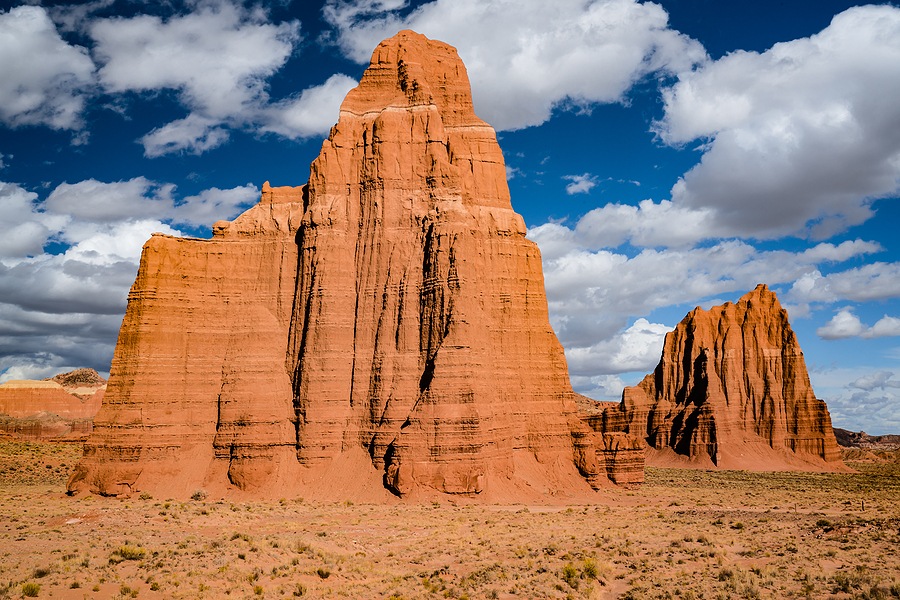
If you’re interested in discovering more of the park, consider exploring one of the below dirt roads. While not all of them require a 4WD vehicle, you’ll be rewarded with fabulous landscapes not seen from the main area of the park. Know your vehicle’s limits as a tow would be a long wait and costly.
- Cathedral Valley Loop: A 57.6-mile loop featuring awe-inspiring rock formations, suitable for a full-day adventure.
- Burr Trail Road: Known for its dramatic switchbacks and expansive views of the Circle Cliffs and Long Canyon.
- Notom-Bullfrog Road: A 34-mile route showcasing the eastern side of the Waterpocket Fold.
9. Fish in the Fremont River
The Fremont River provides a peaceful setting to cast a line. Several stretches of the river near the Fruita area are ideal for fishing.
10. Hike!
Best Capitol Reef Hikes with Kids
The park has 15 day hikes you can complete with your family. We recommend any of the hikes designated as easy and the popular Hickman Bridge and Cassidy Arch hikes.
Easy Hikes
All of these hikes are beginner-friendly and suitable for families with children. Be sure to wear sturdy shoes, bring plenty of water, and avoid hiking during the heat of the day, especially in summer. These trails not only explore the beauty of Capitol Reef but also help kids learn about geology, history, and wildlife.

1. Capitol Gorge
This flat, family-friendly trail follows an ancient road through a deep canyon with towering sandstone walls. Along the way, you’ll encounter historic inscriptions known as the “Pioneer Register,” where early settlers left their names etched into the rock. There’s also a short climb to view natural waterpockets, making it an interactive and educational experience for kids.
Distance: 2.0 miles round trip, Approximate Time: 1–1.5 hours
2. Goosenecks Overlook
A quick, easy walk to a stunning viewpoint where you can gaze down at the dramatic twists and bends of Sulphur Creek far below. This short hike is especially good for families seeking beautiful views without a strenuous climb, and it’s ideal for sunrise views.
Distance: 0.2 miles round trip, Approximate Time: 10–15 minutes
3. Sunset Point
This gentle, well-marked trail leads to a viewpoint offering breathtaking panoramic views of the park’s colorful cliffs and intricate rock formations. As the name suggests, it’s a perfect spot to watch the sunset, with the light illuminating the rugged landscape in brilliant hues.
Distance: 0.8 miles round trip, Approximate Time: 30 minutes
4. Grand Wash
This relatively flat trail takes you through a narrow, dramatic canyon with towering walls that seem to close in on you as you walk through. It’s an awe-inspiring experience as you’ll feel like you’re journeying through a secret passage. The cooling shade in the narrows makes it a great option for midday hikes
Distance: 4.4 miles round trip, Approximate Time: 2–3 hours
Moderate Hikes
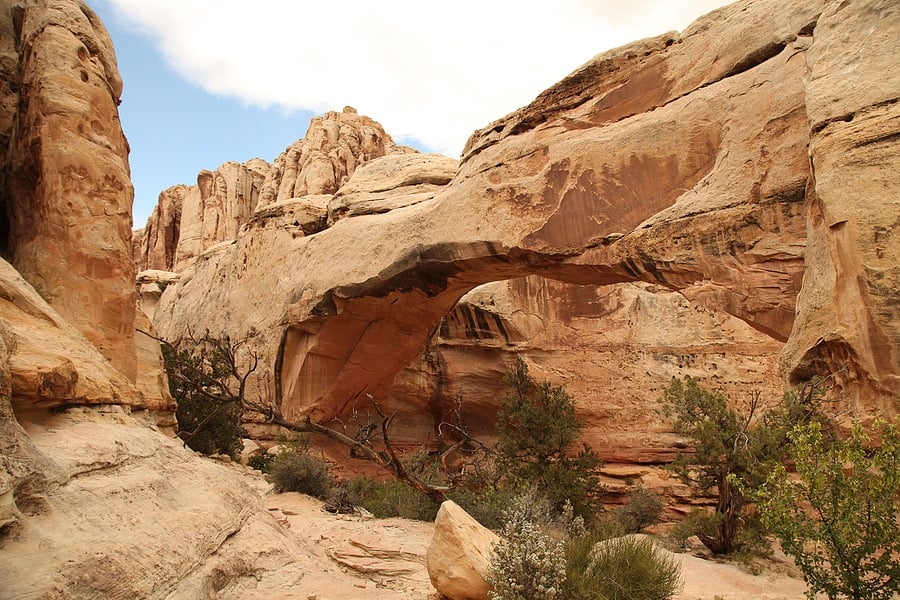
1. Hickman Bridge
This popular, family-friendly trail leads to a stunning 133-foot natural rock bridge. The hike starts along the Fremont River and ascends gently through a scenic desert landscape filled with junipers, sagebrush, and unique rock formations. Along the way, you’ll pass a small natural arch and learn about the area’s geology and history from interpretive signs. Once you reach Hickman Bridge, the towering red rock arch offers an incredible spot and shade under its majestic span.
Distance: 1.8 miles round trip, Approximate Time: 1–1.5 hours
2. Fremont River
This serene trail begins near the Fruita Campground and offers a peaceful walk along the Fremont River. Initially flat and easy-going, the trail transitions into a moderately steep climb toward the end, rewarding hikers with breathtaking panoramic views of the river and lush Fruita orchards below. Along the way, you’ll enjoy a mix of vibrant riparian scenery and contrasting desert landscapes. It’s an excellent option for families or hikers who enjoy both a mellow walk and a touch of adventure with the uphill climb.
Distance: 2.0 miles round trip, Approximate Time: 1–1.5 hours
3. Cohab Canyon Trail
This hidden gem of a trail starts with a steep ascent that climbs switchbacks up the cliffside, but once at the top, the effort is well rewarded. The trail leads you into a secluded canyon filled with unique rock formations, narrow passages, and colorful sandstone walls. Hikers can also take short side trails to scenic overlooks offering stunning views of the Fruita Valley and its orchards below.
Distance: 3.4 miles round trip, Approximate Time: 2-3 hours
Strenuous Hikes
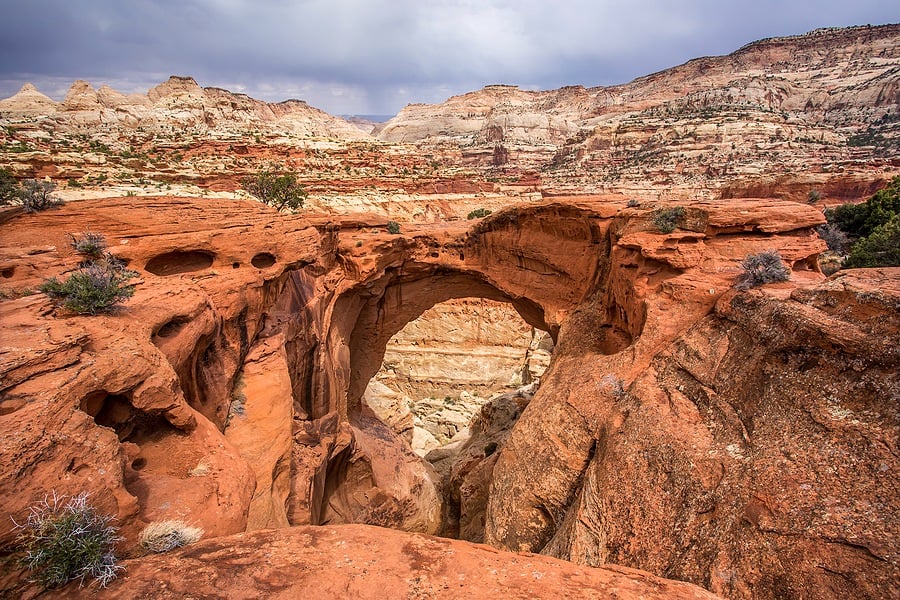
Capitol Reef’s strenuous hikes offer adventurous familis the chance to explore some of the park’s most dramatic and breathtaking landscapes. Whether climbing steep switchbacks, traversing slickrock, or scaling rugged cliffs, these trails provide stunning rewards for those willing to tackle the challenge. Highlights include the Cassidy Arch Trail (3.4 miles round trip), a thrilling route that leads to one of the park’s most famous landmarks—an impressive natural arch perched high above a canyon. The Chimney Rock Trail (3.6 miles round trip) offers panoramic views of Waterpocket Fold cliffs and is particularly beautiful during golden hour. For those seeking even more expansive vista points, Rim Overlook (4.6 miles round trip) and Fremont Gorge Overlook (4.6 miles round trip) feature sweeping views of Fruita and beyond, rewarding hikers with stunning perspectives of the park’s unique geology.
More advanced routes like the Golden Throne Trail (4.0 miles round trip) and the Frying Pan Trail (5.8 miles round trip) Take some effort, but you’ll be rewarded with quiet trails and the chance to explore some of the park’s hidden treasures. For experienced hikers, the Navajo Knobs Trail (9.4 miles round trip) offers the ultimate challenge in the park, featuring a steep ascent to a breathtaking 360-degree mountaintop view.
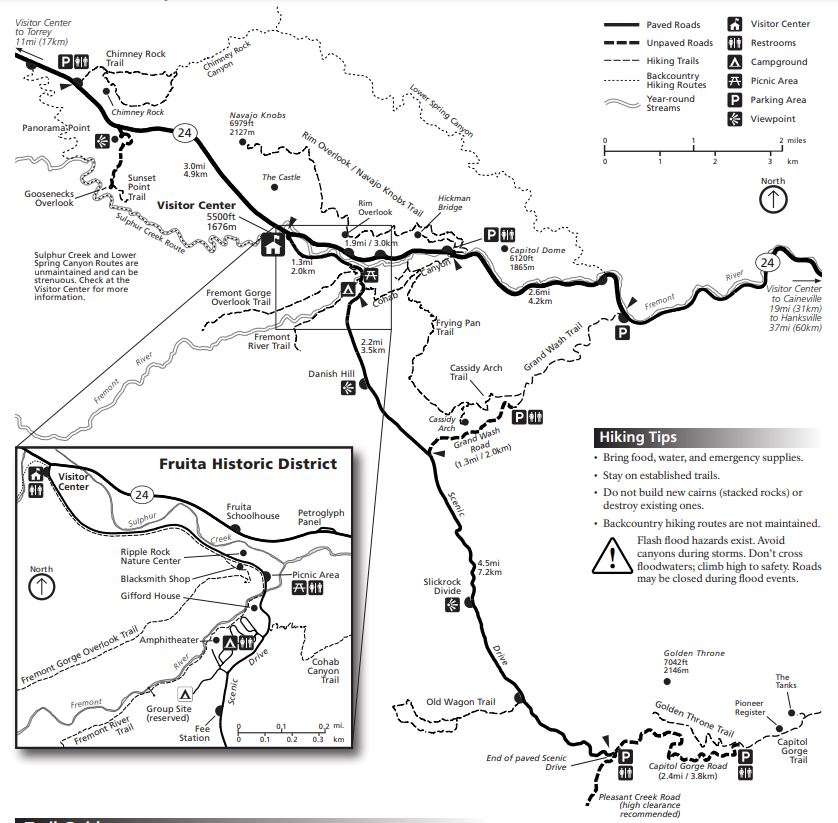
How Many Days Do You Need at Capitol Reef National Park?
You can visit Capitol Reef in half a day if you don’t hike. If you add a couple of short hikes, you can extend your time to a day. Exploration of the North (Cathedral Valley) District of the park will add another day to your visit.
One Day Itinerary
If you only have one day to explore Capitol Reef National Park, you can still enjoy many of its highlights by starting early and making the most of every moment. Begin your day at the Visitor Center as soon as it opens. This is the perfect place to grab a park map, learn about current conditions, and pick up a Junior Ranger booklet if you’re traveling with kids. Watch the short orientation film to learn about the park’s incredible geology and history.
From there, head to Hickman Bridge or Cassidy Arch for your first hike. Hickman Bridge is shorter and easier, leading you to an impressive natural arch with incredible views of the surrounding landscape. Cassidy Arch, on the other hand, is a bit more challenging but rewards you with the chance to stand above a massive arch perched high on a cliff.
Take a break to enjoy lunch at the Fruita Picnic Area. Find a shady spot in the historic Fruita District, where you’ll be surrounded by lush orchards, grassy fields, and the softly flowing Fremont River. Eat your packed lunch and then stop by the Gifford House to pick up a fresh pie or cinnamon roll, just be sure to get there early before their famous baked goods sell out.
Continue your visit by taking a relaxing drive along the Capitol Reef Scenic Drive, an 8-mile paved road that winds through the park. Plan to spend some time stopping at the marked viewpoints and exploring the two dirt spur roads, Grand Wash and Capitol Gorge, if your vehicle allows.
Head back to visit the Petroglyph Panel along UT-24 for an up-close glimpse of ancient art left behind by the Fremont Culture over 1,000 years ago. This quick stop features a short boardwalk where you can view intricate carvings of human figures, animals, and mysterious symbols. It’s a perfect way to connect with the history of the area and a fun way to ask your kids to interpret the carvings.
Finally, head to either Goosenecks Overlook or Sunset Point to watch the sun dip below the horizon, enjoy the warm colors of orange, pink, and gold across the park’s rock formations.
Day Two Itinerary
For your second day, start with an early drive to the end of the Scenic Drive and hike Capitol Gorge, a beautiful and accessible trail that takes you through a narrow canyon with towering sandstone walls and remnants of history, like the Pioneer Register.
Afterward, consider exploring one of the park’s dirt roads for a more remote adventure. The Cathedral Valley Loop, a 57.6-mile journey, takes 6 to 8 hours to complete and features breathtaking rock formations like the Temples of the Sun and Moon. Alternatively, you can venture onto the Burr Trail Road, a 66-mile route that can take 3 to 4 hours to cover (one way) and offers dramatic views of Long Canyon, colorful cliffs, and sweeping desert landscapes.
For adventurous families, try hiking Sulphur Creek, an unofficial 5.8+ mile trek requiring 4 to 6 hours for wading through water, scrambling down slickrock, and passing small waterfalls—a fun challenge that rewards with stunning scenery.
Entrance Fees for Capitol Reef National Park
Private vehicle entrance fee is $20.
We highly recommend buying an America the Beautiful pass for $80. The pass is good for one calendar year and is your ticket to more than 2,000 federal recreation sites. Having a pass will allow you to pop in for a few hours in the evening and again the next morning.
If you have a 4th grader, check out the FREE Annual 4th Grade pass which is good for the duration of the school year through the following summer (September-August).
Current U.S. military members and their dependents in the Army, Navy, Air Force, Marines, Coast Guard, and Space Force, as well as Reserve and National Guard members, qualify for a free annual pass.
Can You see Capitol Reef and Bryce Canyon in One Day?
If you don’t do any hiking and only complete the scenic drives, you might be able to do both parks in one day. However, we recommend driving Scenic Byway 12 between the parks which offers many places to stop and enjoy the scenic views.
Best Time to Visit
The best time to visit Capitol Reef National Park is during spring (March to June) and fall (September to October), when temperatures are mild, ranging from the 60s to the 80s (°F), making hiking and exploring enjoyable. We visited in mid-May and found the crowds to be light. Spring brings vibrant wildflowers, while fall offers cooler weather and lighter crowds, creating an ideal atmosphere for outdoor activities. These seasons are popular, so arriving early in the day is recommended to avoid crowded trailheads.
Summer (June to August) can be hot, with midday temperatures often reaching into the 90s, though mornings and evenings are cooler and more comfortable for hiking. Winter (November to February) offers a quieter experience, with cooler temperatures and occasional snow dusting the red rocks, though some facilities may be limited.
12 Tips for Visiting Capitol Reef with Kids
- Explore Beyond the Main Park Area:
Don’t limit your visit to just the Scenic Drive. Take time to explore Utah State Route 24 (UT-24) as well, which offers scenic pullouts, petroglyph panels, and trailheads like the Hickman Bridge and Sunset Point hikes. This highway is filled with stunning views and hidden gems. - Prepare for the Desert Sun:
Capitol Reef has limited shade, so pack essentials like hats, sunglasses, sunscreen, and lightweight clothing to protect yourself from the harsh desert sun. Staying hydrated is a must—bring plenty of water for everyone in your group, whether you’re hiking or simply driving through the park. - Start Early for Cooler Temperatures:
Plan your hikes for the early morning or late afternoon to avoid the hottest part of the day. Early visits also help you beat the crowds at popular trailheads and scenic viewpoints, especially during the busy spring and fall seasons. - Arrive Early for the Famous Pie at Gifford House:
Make the Gifford House a priority stop but plan ahead—its freshly baked pies and unique treats, made from fruit harvested from local orchards, often sell out by mid-afternoon. Arriving early ensures that you can enjoy this sweet park tradition. - Stock Up on Supplies Before You Arrive:
While the nearby town of Torrey offers basic amenities like groceries and gas, there are limited options for supplies within the park itself. If you’re traveling from Moab, Salt Lake City, or Bryce Canyon, plan to stock up on food, drinks, and any hiking gear before reaching Capitol Reef. - Stay Hydrated and Know Your Limits:
The desert climate, combined with higher elevations, can take a toll on hikers. Bring more water than you think you’ll need, take breaks often, and pace yourself, especially on moderate or strenuous trails. Listening to your body is key to enjoying your adventure safely. - Visit the Park at Night for Stargazing:
Capitol Reef is a designated Dark Sky Park, meaning it’s one of the best places for stargazing. If your schedule allows, plan for an evening or overnight stay to marvel at the incredible blanket of stars and constellations above the red rock formations. - Pay Attention to Educational Signs:
Throughout the park, you’ll find interpretive signs at scenic pullouts, trailheads, and viewpoints. These help you understand the fascinating geology, history, and culture of the area, including insights into the Fremont Culture that lived here over 1,000 years ago. - Beat the Busy Parking Lots:
Popular trails and trailhead parking lots—such as Hickman Bridge or Grand Wash—can fill up by mid-morning during peak months. Arrive early or plan to hike later in the day for the best chance at securing a spot. Alternatively, consider visiting in the shoulder seasons for fewer crowds. - Take Advantage of Facilities:
Flush toilets are available year-round at the Fruita Campground and seasonally at the Doc Inglesby Picnic Area. Pit toilets are also located at most trailheads. Make note of these facilities so you can plan accordingly during your visit. - Respect the Desert Environment:
Capitol Reef’s fragile desert ecosystems require care. Stay on marked trails to protect plants and minimize erosion, and pack out all trash. If you’re fruit picking in the orchards, only take fruit you plan to eat or pay to take home, so there’s enough for everyone. - Visit Goblin Valley State Park on Your Way:
If you’re traveling from Moab or Salt Lake City to Capitol Reef, consider adding Goblin Valley State Park to your itinerary. Located just a short detour from the main route, this park is famous for its otherworldly rock formations resembling “goblins.”
Where to Stay
Hotels for Big Families
See our big family friendly listings near Capitol Reef. Unfortunately, the area doesn’t offer many choices.
Camping and RV
- Fruita – 71 spaces with picnic tables, fire grates/grills, restrooms, water, and an RV dump station. First come, first served. Fee.
- Cathedral Valley and Cedar Mesa – Primitive site with picnic tables, fire grates/grills, pit toilets, and no water. No fee. First come, first served.
- Backcountry Camping – Permit required, available at the visitor center.
Ideas to Plan Your Trip
Capitol Reef National Park was an unforgettable part of our 8-day Grand Circle Road Trip, including the Grand Canyon and exploring Utah’s Mighty 5 National Parks. The dramatic arches, breathtaking landscapes, and family-friendly hikes made it a highlight of our journey.
For those considering an extended adventure, we also have a 5-day itinerary for visiting Salt Lake City with kids and a detailed guide to eight incredible Utah State Parks featuring big family cabins. These resources are designed to make planning your family vacation easy, memorable, and full of adventure. Don’t miss the chance to create lifelong memories with your loved ones in Utah’s stunning outdoors.
Pin for later!
